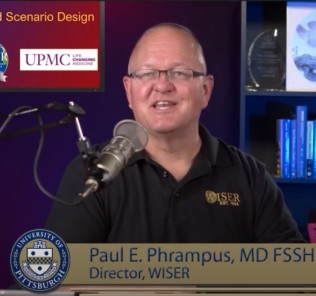How and Why to Place Focus on Healthcare Simulation Pre-brief
The pre-brief phase of healthcare simulation-based education prior to any scenario is an incredibly important and impactful phase to get correct. This article by Erin Carn-Bennett, MSN, RN, will explore and break down the pre-brief phase prior to any clinical simulation-based education and why there is great importance that surrounds this phase of clinical simulation. As clinical simulation educators, there is a lot of importance placed on debriefing. However, the prebrief is equally important to clinical simulation participants so they are set up for success in the clinical simulation scenario.
What is A Prebrief and Why Does This Phase Matter
A prebrief is a dedicated section prior to any clinical simulation that takes place. Prior to clinical simulation education, a pre-brief is to set up clinical simulation participants for success. Despite what debrief methodology is used, a number of common sections of a clinical simulation pre-brief will be used. This article will discuss generalized and common elements of a clinical simulation pre-brief. As a clinical simulation educator, an individualized style often comes with time and practice around what is conducted within a pre-brief before clinical simulation scenarios.
Sponsored Content:
A pre-brief is an adjustment phase for clinical simulation participants to have time to dedicate to transfer into clinical simulation education. Many people need help with clinical simulation-based education, and many clinical simulation participants will come holding onto previous negative clinical simulation experiences. However, an effective pre-brief is a space for clinical simulation participants to gather and be introduced to the clinical simulation facilitator faculty team and to orientate to other clinical simulation participants and their environment. The transition into this clinical simulation educational space and the ability to make sense of the educational experience about to take place will assist in the process to set up clinical simulation participants for success.
Psychological Safety and The Creation of A Safe Space for Participants
Many clinical simulation programs and trained faculty have moved away from surprise clinical simulation scenarios. People like to feel safe and not be tricked into attendance at a clinical simulation. A pre-brief is an honorary way in which clinical simulation participants are given space to adjust to the new environment and also make sense of the educational experience that is about to take place. The pre-brief allows faculty to make clinical simulation a psychologically safe environment and value the learners who drive the educational experience. The pre-brief is an excellent opportunity to build the foundations of a trusting relationship between faculty and the learner. Every step in a pre-brief for clinical simulation should be designed to enhance and reinforce psychological safety in the clinical simulation scenario experience.
Confidentiality Needs to be Transparent and Valued
Sponsored Content:
A lot of participants who attend clinical simulation-based education are afraid of being judged by clinical simulation faculty or their peers. Often, participants place a lot of additional pressure on themselves and don’t like the thought of others watching their clinical performance. This is completely understandable, and many can behave in ways that would deviate from their usual performance based on the above. This alone speaks volumes as to why an effective pre-brief is essential. A succinct and effective pre-brief is essential for those clinical simulation participants who struggle with pressure they place on themselves. An effective pre-brief will assist with psychological safety and engagement in all clinical simulation scenarios and assists with the drive to attend future sessions. Confidentiality must be verbalized to participants, and their performance will not be shared with anyone outside of the clinical simulation scenario. Faculty need to live these values as they are incredibly important for the maintenance of participant psychological safety.
View the LEARN CE/CME Platform Webinar Introducing INACSL’s New Simulation Standard: Prebriefing to learn more!
Simulation Strategies to Increase Success
A big part of a pre-brief is to outline the rules within the clinical simulation. Rules may include how to ask for assistance, what equipment can be used and not used, how to perform procedures such as intravenous line insertion, and teamwork principles. These rules help to remind the participants to treat the manikin just as a patient would be treated and to practice effective communication and teamwork skills. The clinical simulation will only be a success if participants suspend disbelief and get engaged. The pre-brief sets up participants for success and acknowledges the difficulty that surrounds a transition into clinical simulation-based education.
Adult learners like to be prepared to engage in education and take on learning. Therefore, the outline of what to expect within the pre-brief prior to the clinical simulation is of great importance. This should include how long the clinical simulation will take overall as well as how long each section, such as the pre-brief, clinical simulation, and debrief, will take. This is particularly important if the clinical simulation occurs in an in situ clinical space. When staff have other clinical commitments handed over, their engagement is more likely to be better if there is an awareness of how long to expect the clinical simulation scenario will take.
An introduction to the clinical simulation manikin is an incredibly important part of the pre-brief, which can often be overlooked. Get the clinical simulation participants to put their hands on the manikin and learn about the features offered if the manikin is high fidelity. The ability to listen to chests and feel pulses can assist to normalize the manikin to participants and allow clinical simulation participants to be engaged prior to the clinical simulation.
This article has explored the pre-brief phase of clinical simulation and the importance that surrounds this. No particular pre-brief methodology has been referred to; however, common parts of a clinical simulation pre-brief have been discussed, such as allowance for participants to transfer into clinical simulation education and be set up for success. Other items discussed included psychological safety, confidentiality, and rules for the clinical simulation. As faculty members, there is importance to get things right for participants. A pre-brief is a way to give clinical simulation participants the best chance of success in the scenario.
Erin Carn-Bennett is a Simulation Nurse Educator for the Douglas Starship Simulation Programme in Auckland, New Zealand. Carn-Bennett has a Master of Nursing and has an extensive nursing career within pediatric emergency and also nursing management. She is passionate about debriefing and all psychologically safe simulation delivery. Carn-Bennett is a member of the IPSS board of directors. Carn-Bennett is the lead host of the podcast Sim Nurse NZ and co-host of IPSS The Podcast. Erin is the Nursing Director of the company Med Sim Solutions.
Sponsored Content:





















